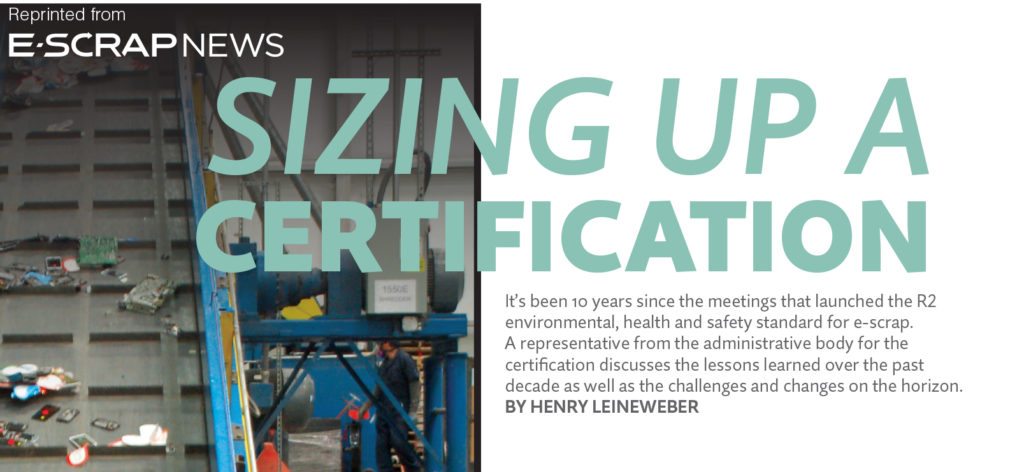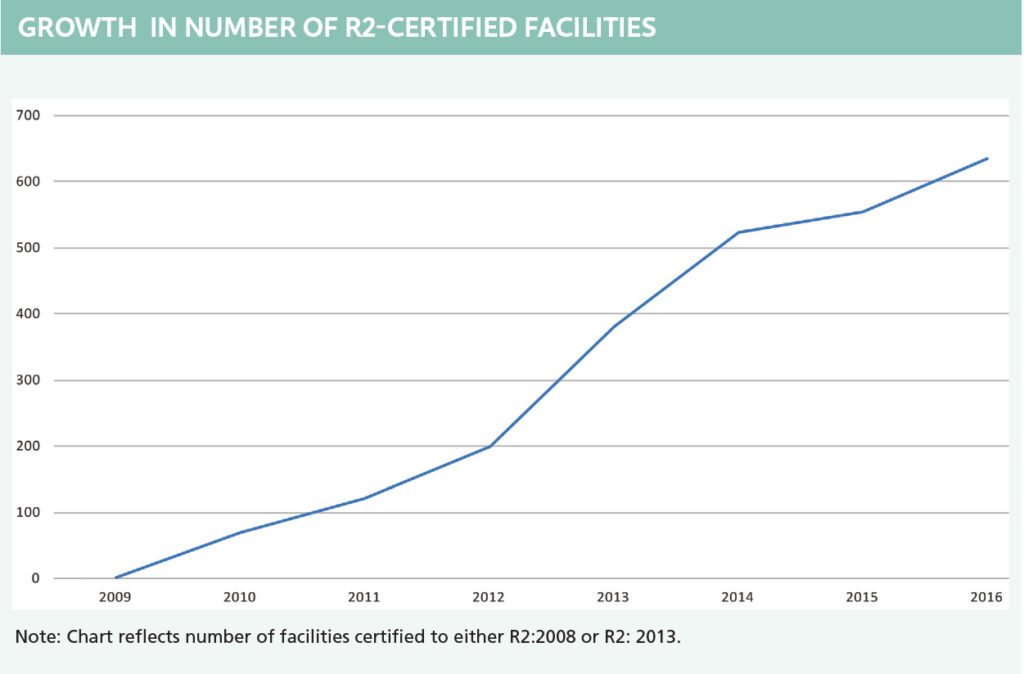This story originally appeared in the September 2016 issue of E-Scrap News.
Subscribe today for access to all print content.

A decade ago, a group of recycling leaders, EPA officials, OEMs, and nonprofit stakeholders met to develop ways to improve the environmental quality and worker safety of the electronics recycling industry. The result became the R2 standard – a common set of criteria, best practices and processes designed to reduce or eliminate environmental, health and safety issues associated with electronics repair and recycling. The idea was that by implementing the standard at as many facilities as possible, real and meaningful improvements in the overall quality of the electronics recycling industry could be achieved.
So how effective has the standard been? Relative to the state of the industry when the certification program was created, we have made good progress.
In total, there are now over 620 R2-certified sites in 21 countries. R2-certified facilities represent between 40 and 45 percent of all U.S. and Canadian e-scrap sites, making it the largest e-scrap certification program used in North America. Furthermore, material repaired or recycled by R2-certified sites accounts for the vast majority of all e-scrap processed in the U.S.
SERI (Sustainable Electronics Recycling International), the group that administers the standard, believes R2 has succeeded thanks in large part to its broad appeal and overall utility. However, will these two factors carry forward in the coming years? How can R2 continue to serve as a useful tool for the recycling community both in the U.S. and beyond?
Adoption: The big tent standard
Let’s talk about the appeal of the standard and how that has affected its overall success. With R2 having now gone through a complete revision process – and about to start on a second – the standard owes much of its appeal to its active engagement with recycling companies, OEMs, regulatory bodies, environmental advocates and other stakeholders.
The standard’s roots are in consensus-based, multi-stakeholder bodies. These groups, which include the R2 Technical Advisory Committee, proved invaluable in helping create a set of best practices that could both raise the bar for environmental, health, and safety (EH&S) practices and appeal to a broad set of repair and recycling organizations. Each stakeholder brought its own concerns, expertise and enthusiasm to the process, and the R2 standard was better for it.
The stakeholders that developed and continue to refine the R2 standard – in addition to other groups such as companies in the R2 Leaders program, consultants and compliance professionals – collectively represent a powerful coalition interested in advocating for R2, both the standard itself and the principles contained within it.
An oft-used example of this can be found in how R2 addresses the repair and reuse of electronics. The standard is based on the premise that reuse is the best way to manage used electronics and includes criteria for the testing, labeling, resale and reuse of used electronics. Repair and reuse are more environmentally friendly than scrapping a piece of otherwise usable equipment, and for many R2 stakeholders, repair and reuse simply makes more business sense. Repair, reuse, asset management and component sales are more profitable for many businesses than material recovery – particularly while commodity prices remain low. By participating in the standard-development process, stakeholders in the repair community made sure their perspective was reflected and made sure R2 would have broader appeal in the marketplace as well.
In another example, input from OEMs has been critical in driving the adoption of R2 (and more broadly, third-party certification) in the U.S. OEM input helped shape the provisions of R2 in areas such as asset tracking, cross-border movement, security and downstream documentation – all areas the R2 Standard continues to refine and improve upon with each subsequent revision. While almost all OEMs utilize their own rigorous requirements for in-house and third-party repair, recycling and data-security service providers, many have also begun to incorporate certification into their vendor selection processes. Approximately 43 percent of all PCs shipped in the U.S. in 2016 will be specifically required to be managed by a certified recycling operation (either R2 or e-Stewards) at the end of their useful lives, according to the vendor qualification programs developed by their respective OEMs. Many local governments, enterprises and other stakeholders have similar requirements, including 26 percent of Fortune 100 companies.
In short, process matters. Without the active participation of its various stakeholders, R2 simply wouldn’t exist – or at the very least, would not be as widely used as it is now.
 Implementation: The nuts and bolts
Implementation: The nuts and bolts
Let’s shift focus to the utility of the R2 standard. How effective is it and what is its core value?
SERI is continually working to improve its measurement and evaluation programs to gauge the effectiveness of the standard, but we can confidently point to several areas of improvement among certified sites. First and foremost, the use of third-party audited EH&S certifications and management systems has dramatically increased in the e-scrap repair and recycling sector.
According to SERI’s internal polling of R2-certified facilities, 74 percent of currently certified R2 sites did not have an EH&S management system in place prior to deciding to become R2 certified. R2 specifically requires the use of approved third-party EH&S certifications, with the majority of R2-certified facilities choosing to utilize a combination of ISO 14001 / OHSAS 18001 for their management system (ISO 14001 / AS-NZS 4801, or RIOS are also acceptable). These management systems require careful documenting of environmental or occupational safety areas of concern, and the utilization of specific, measurable and accountable continuous improvement goals. In fact, the latest version of ISO 14001, to which many R2 facilities are currently updating, more directly integrates top-level management and key decision-makers into this “plan, do, check, act” process.
Furthermore, R2-certified recycling operations are implementing other best practices they previously wouldn’t have. Approximately 54 percent of R2-certified facilities created downstream vendor selection criteria and due-diligence reporting processes in order to become R2 certified. Additionally, 65 percent report an overall increase in workplace safety, and 64 percent of certified facilities say they created a facility closure plan because of their pursuit of R2 certification.
Finally, electronics refurbishers and recycling companies have realized that their customers want responsible practices. As mentioned above, certification is often a requirement to secure contracts from larger generators of used electronics. In fact, 84 percent of those polled by Arcadian Solutions reported that certification added at least some value to their businesses. SERI’s polling has shown similar results, with 81 percent of respondents saying R2 certification has helped them attract new business.
Certification programs lead to clear improvements in a facility’s record-keeping processes, employee training, risk mitigation, accident reduction and other areas. That said, we still have a lot more work to do.
A focus on emerging markets
The R2 Standard faces many known and unknown challenges in the coming years, but two stand out: The standard needs significantly higher adoption in foreign countries, and it needs to improve the efficiency and effectiveness of implementation.
Regarding adoption, simply put, the next version of the R2 standard must include more input from stakeholders in regions outside North America – and specifically, more input from stakeholders in emerging markets.
While R2-certified facilities can now be found in 21 countries, the majority of certified sites (approximately 88 percent) are in the U.S. and Canada. This is slowly changing, but if the electronics repair and recycling industry is going to improve in the places it needs to improve, the pace of growth overseas needs to significantly accelerate.
We’ve established that R2 owes much of its success to outreach, engagement and inclusion of multiple stakeholders in the development and continual refinement of the standard. It stands to reason then that widespread adoption in markets outside North America will require similar steps. The challenges with this approach are identifying the right stakeholders, and then once identified, creating consensus among the significantly more diverse stakeholder group.
SERI is working to identify professional associations, prospective operations for certification and interested individuals in Latin America, South Asia, and the Pacific Rim, but we are always seeking ways to improve this process, whether it is through referrals and recommendations, partnerships, research, or other methods.
Regarding implementation, there is clear room for improvement in terms of quality-control and monitoring.
Everyone in the electronics recycling industry is acutely aware of the problems posed by bad actors and their potential to undermine the integrity of certification programs and the industry as a whole. Specific incidents have been profiled in numerous media outlets, and we take any effort to undermine the integrity of the standard very seriously.
In addition to the required annual audits conducted by certification bodies, for the past year SERI has conducted unannounced spot audits of repair and recycling sites. These have been useful in identifying areas of concern either missed by an auditor or that arose in between annual audits. SERI typically does not publicize discovered non-conformances or disciplinary action taken against specific companies. However, in the past year quality assurance activities conducted by both SERI and certification bodies resulted in numerous suspensions and over a dozen revocations of R2 certificates.
We have also recently launched a standardized auditor training and evaluation program that all R2 auditors will be required to participate in. The intent is to reduce variability in what an auditor looks for, how an audit is conducted and what an audited operation can expect. Initial feedback has been positive, and SERI will continue to refine the program as it progresses in the coming months.
Both the auditor training and spot audit programs are first steps, and our hope is to expand their use in the future – ideally coupled with new quality assurance tools.
Implementation issues in new markets are also specifically tied to the infrastructure needed to support certification. We take it for granted in North America that there are numerous consultants, auditors, insurance products and other resources necessary to complete R2 certification. We also take it for granted that these resources are all in our native language. And, finally, we take it for granted that this certification infrastructure is available at a price point scaled appropriately for comparable professional services. None of this can be said for the certification process outside developed countries.
SERI has invested in translating the R2 standard, guidance and other materials into multiple languages, all of which are freely available on sustainableelectronics.org. Furthermore, SERI’s previously mentioned auditor training program will include sessions designed for new auditors working in India, China, Latin America and other regions. While this is a good start, much more work needs to be done.
Boosting vigor and appeal in the market
The R2 certification has come so far in such a short period of time. It has not been without growing pains, but it has had an overwhelmingly positive effect on the electronics repair and recycling community over the course of its brief existence.
As SERI looks ahead to the potential next version of the standard, our focus is on continuing to improve the standard’s utility, rigor and market appeal. Doing so will require the participation of many voices – some who we’ve heard since the beginning, but many more who will be new.
Together, we can continue to grow R2 into a truly global standard, and continue to create positive change.
Henry Leineweber is the operations director for SERI (Sustainable Electronics Recycling International). In this capacity, he provides operational support, project oversight and relationship management for the organization. Prior to joining SERI, he was the managing editor of E-Scrap News. He can be contacted at [email protected].


 Implementation: The nuts and bolts
Implementation: The nuts and bolts